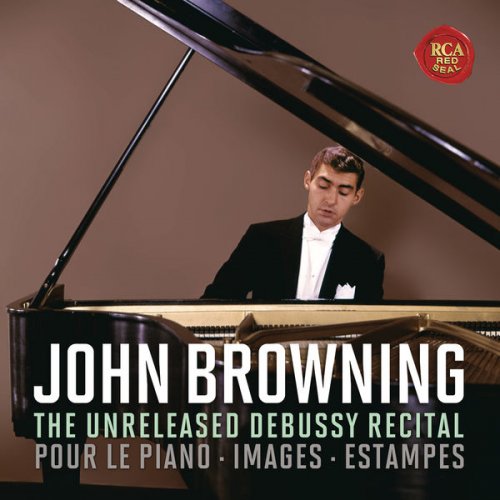John Browning - The Unreleased Debussy Recital: Pour le piano, Images & Estampes (2017) [Hi-Res]

Artist: John Browning
Title: The Unreleased Debussy Recital: Pour le piano, Images & Estampes
Year Of Release: 2017
Label: RCA Red Seal
Genre: Classical, Modern Era, Impressionist, Piano
Quality: flac lossless / flac 24bits - 96.0kHz
Total Time: 00:57:07
Total Size: 217 mb / 1.1 gb
WebSite: Album Preview
TracklistTitle: The Unreleased Debussy Recital: Pour le piano, Images & Estampes
Year Of Release: 2017
Label: RCA Red Seal
Genre: Classical, Modern Era, Impressionist, Piano
Quality: flac lossless / flac 24bits - 96.0kHz
Total Time: 00:57:07
Total Size: 217 mb / 1.1 gb
WebSite: Album Preview
---------
01. Pour le piano, L. 95: I. Prélude. Assez animé et très rythmé
02. Pour le piano, L. 95: II. Sarabande. Avec une élégance grave et lente
03. Pour le piano, L. 95: III. Toccata. Vif
04. Images, Set I, L. 110: I. Reflets dans l'eau. Andantino molto
05. Images, Set I, L. 110: II. Hommage à Rameau. Lent et grave
06. Images, Set I, L. 110: III. Mouvement. Animé
07. Images, Set II, L. 111: I. Cloches à travers les feuilles (mélancolie diffuse)
08. Images, Set II, L. 111: II. Et la lune descend sur le temple qui fut
09. Images, Set II, L. 111: III. Poissons d'or (vif)
10. Estampes, L. 100: I. Pagodes-Moderement anime
11. Estampes, L. 100: II. La soiree dans Grenade-Mouvement de Habanera
12. Estampes, L. 100: III. Jardins sous la pluie-Net et vif
John Browning ranks among the very few truly virtuoso pianists of the post-Vladimir Horowitz era. A large technique, the ability to draw a broad spectrum of colors and deep reserves of sound from his instrument, and total investment in his work marked him as one of the most important artists of his time. Among his American contemporaries, he alone sustained a career in which there was only a steady enrichment of artistry without detours caused by injury or emotional crisis. His parents were both musicians: his father a violinist, his mother a pianist. He grew up in Denver and began keyboard studies at five years of age. He recalled the aftermath of a civic concert in which composer/pianist Béla Bartók and violinist Joseph Szigeti visited his parents' home and he saw his mother sitting at her piano turning pages for Bartók. His first public appearance came as soloist with the Denver Symphony at the age of 10. Summer classes with Josef and Rosina Lhévinne led to more extended study with Mrs. Lhévinne at Juilliard School of Music in New York. When the family moved to Los Angeles, further studies with Lee Pattison solidified an increasingly solid technique and introduced him to most of the works that formed his repertory. Several major awards propelled Browning to a successful career. In 1954, he won the Steinway Centennial Award, in 1955 he placed first in the esteemed Leventritt Competition, and in 1956 he gained second prize in the Queen Elisabeth International Music Competition in Brussels. In 1956, Browning made his debut with the New York Philharmonic and afterward appeared in nearly every important music center in the world. His debut recording, taped when he was 25, revealed a fully fledged musician, already in complete possession of a polished technique and a probing musicality. Browning's artistry attracted the attention of composer Samuel Barber, and in 1962 a new piano concerto was introduced to the public in New York with Browning performing under the direction of Erich Leinsdorf. The Barber Piano Concerto was applauded by critics and audience alike and has, ever since, remained the centerpiece of Browning's repertory. Two recordings were made, the first with George Szell and the Cleveland Orchestra, the second with Leonard Slatkin directing the Saint Louis Symphony. The latter was awarded the first of two Grammys won by Browning (his second was for a collection of Barber solo piano pieces). A select repertory, all of it tailored to a pianist of Olympian power and authority, embraced Mozart, Beethoven, Chopin, Brahms, Tchaikovsky, Rachmaninov, Prokofiev, and Ravel. Among later 20th century composers, Barber figured prominently, as did Richard Cumming. In addition to appearances with most of the major orchestras in the United States and Europe, Browning toured Russia on four occasions and was a regular guest at America's most celebrated summer festivals. He performed into the new century, his last appearances being in Washington, DC, in the spring 2002. He died from heart failure at his home in early 2003.
![Juan Torres Fernández - Azul Cristalino (2025) [Hi-Res] Juan Torres Fernández - Azul Cristalino (2025) [Hi-Res]](https://www.dibpic.com/uploads/posts/2025-12/1765496468_y7dxox9hmk6hb_600.jpg)

![Sam Most - But Beautiful (2025) [Hi-Res] Sam Most - But Beautiful (2025) [Hi-Res]](https://img.israbox.com/img/2025-12/12/n19esmi2zxvr716zw8citn0dv.jpg)





![Kenny Wheeler, Keith Jarrett, Dave Holland & Jack DeJohnette - Gnu High (1976/2025) [Hi-Res] Kenny Wheeler, Keith Jarrett, Dave Holland & Jack DeJohnette - Gnu High (1976/2025) [Hi-Res]](https://www.dibpic.com/uploads/posts/2025-12/1765627312_cover.jpg)